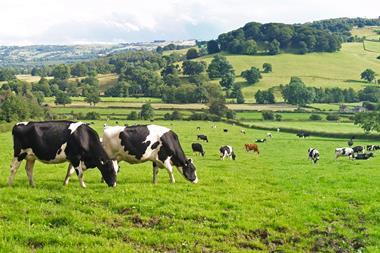MLC doubts lower feed prices will ease herd contraction
Feedgrain is a big proportion of variable cost in parts of the livestock industry ---- perhaps 70% for pigs, for instance, and more for poultry. In effect, pork and poultry retailers are selling recycled cereals.
Relatively small volumes and high prices of the UK-produced grain used as animal feed have added to the financial pressure on the livestock sector in the past couple of years.
Manufactured livestock feed production in this country fell only slightly last year, despite the declines in the cattle, sheep and pig numbers due in part to the FMD crisis, according to DEFRA.
The explanation, as MLC analysts point out, was a very sharp rise in poultry feed production, which supports all the other evidence of a price-crushing broiler output surge.
Now it seems cereal production will increase strongly in the current season. Does this imply abundant, much cheaper rations for the animals, and as a consequence increased meat production?
"Livestock farmers should feel the benefit of lower feed prices," according to the MLC analysts, yet they are sticking with their forecasts of cattle and pig herd contraction and negligible growth in the sheep flock.
A possible reason, not mentioned by the MLC, is the notorious difficulty of forecasting grain prices. Cereals traders like to claim their commodity market is much more sophisticated than meat, at least in the UK, and the availability of futures contracts as price hedging mechanisms is alleged to make the spot market even harder to predict.
{{MEAT }}
Close menu
- Home
- Retail & Wholesale
-
Products & Suppliers
- Back to parent navigation item
- Products & Suppliers
-
Product Categories:
- Back to parent navigation item
- Product Categories:
- Alcoholic drinks
- Bakery
- Cereals & breakfast
- Cheese
- Chicken & poultry
- Chocolate
- Confectionery
- Crisps, nuts & snacks
- Dairy
- Fish
- Fresh produce
- Frozen
- Household
- Meat
- Own Label
- Sauces & condiments
- Seasonal
- Soft drinks
- Vaping
- Vegan & plant-based
- World foods
- Suppliers
- People
- Reports & Data
-
Topics A-Z
- Back to parent navigation item
- Topics A-Z
-
Popular topics:
- Back to parent navigation item
- Popular topics:
- Cost of living crisis
- Crime
- Deposit Return Schemes
- Finance
- Government & Regulation
- Health
- Inflation
- Loyalty
- Marketing
- Mergers & Acquisitions
- New Product Development
- Sourcing
- Supply chain
- Sustainability & environment
- Technology
- Ultra Processed Foods
- Vaping
- A-Z all topics
- Content by type:
- Events
- Subscribe now
Sign in to comment on this article
Not logged in before? Register for FREE guest access today.
You will be able to:
- Read more stories
- Receive daily newsletters
- Comment on stories
Advert


















No comments yet